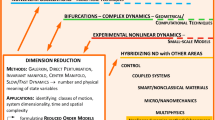Abstract
Explanation of the methods, techniques, and theoretical aspects of experimental structural dynamics requires a fundamental understanding of several mathematical concepts. Data acquisition and analysis and their relationship to structural dynamics theory rely on an understanding of domains and transforms. Theoretical and computational methods in structural dynamics (modeling, correlation, parameter estimation, etc.) make use of linear algebra concepts and techniques. This chapter presents the fundamentals of these concepts and methods.
Access this chapter
Tax calculation will be finalised at checkout
Purchases are for personal use only
Similar content being viewed by others
Abbreviations
- ω :
-
Frequency, radians/second
- f :
-
Frequency, Hertz (cycles/second)
- t :
-
time, seconds
- s :
-
Laplace variable, radians/sec
- j :
-
\( \sqrt{-1} \)
- a n, bn:
-
Fourier Series coefficients
- c n :
-
Fourier Series coefficients (complex form)
- θ :
-
Angle, radians
- [A]:
-
Matrix
- {x}:
-
Vector
- \( \dot{x} \) :
-
First time derivative of x
- \( \ddot{x} \) :
-
Second time derivative of x
- [A]nxm:
-
Matrix consisting of n rows and m columns
- σ :
-
Eigenvalue
References
Bendat JS, Piersol AG (2000) Random data analysis and measurement procedures, 3rd edn. ISBN: 0471-31733-0
Golub GH, Van Loan CF (2012) Matrix computations, 4th edn. Johns Hopkins University Press. ISBN-13: 978-1421407944
Hayek SI (2001) Advanced mathematical methods in science and engineering, 1st edn. ISBN: 0-8247-0466-5
Kisak PF (ed) (2016) Fourier analysis: ``decomposing a waveform into a harmonic series'', 1st edn. CreateSpace Independent Publishing Platform. ISBN-13: 978-1523323913
Kreyzig E (2004) Advanced engineering mathematics, 8th edn. ISBN: 9971-51-283-1
Oppenheim AV, Schafer RW (1999) Discrete-time signal processing, 2nd edn. Prentice Hall. ISBN: 0-13-754920-2
Spiegel MF (1974) Schaum’s outline of Fourier analysis with applications to boundary value problems, 1st edn. McGraw-Hill Education. ISBN-13: 978-0070602199
Strang G (2016) Introduction to linear algebra, 5th edn. Wellesley-Cambridge Press. ISBN-13: 978-0980232776
Author information
Authors and Affiliations
Corresponding author
Editor information
Editors and Affiliations
Rights and permissions
Copyright information
© 2022 The Society for Experimental Mechanics
About this entry
Cite this entry
Van Karsen, C., Barnard, A. (2022). Applied Math for Experimental Structural Dynamics. In: Allemang, R., Avitabile, P. (eds) Handbook of Experimental Structural Dynamics. Springer, New York, NY. https://doi.org/10.1007/978-1-4614-4547-0_32
Download citation
DOI: https://doi.org/10.1007/978-1-4614-4547-0_32
Published:
Publisher Name: Springer, New York, NY
Print ISBN: 978-1-4614-4546-3
Online ISBN: 978-1-4614-4547-0
eBook Packages: EngineeringReference Module Computer Science and Engineering




